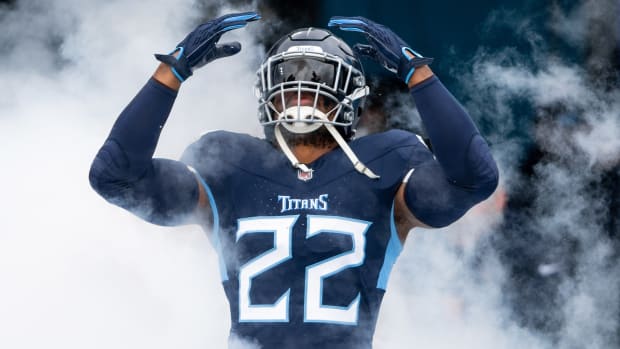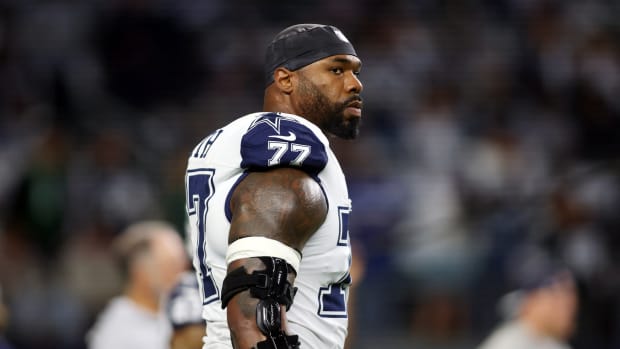Downfield Passing Game Looking Up Again
NASHVILLE – In the three games A.J. Brown missed on injured reserve, the Tennessee Titans’ passing attack ran on dunkin’.
Dink and dunk. Dink and dunk. Quick completions for little yardage.
Big-chunk plays? They were almost non-existent with the third-year receiver sidelined, as the harsh statistics indicate:
• During the three-game stretch against New England, Jacksonville and Pittsburgh, quarterback Ryan Tannehill completed just five-of-19 passes of 10 or more yards downfield, throwing for a total of only 76 yards, zero touchdowns and one interception, per Next Gen Stats.
Did we mention that was a three-game span?
The loss to Pittsburgh was particularly brutal when it came to the Titans’ downfield passing, as Tannehill went one-for-five for 12 yards in passes thrown more than 10 yards downfield. Rock bottom.
Were there some advantages gained by playing the short game in the passing attack? Sure.
• When the Titans did to put together scoring drives, they were almost always long ones. They had six scoring that lasted 10-plus plays in those three games, meaning the Titans were keeping opposing offenses off the field for long stretches.
• Quick throws meant Tannehill got rid of the football sooner, meaning he was less likely to face significant pressure.
• A safer, shorter throw was also less likely to get intercepted, an important factor considering Tannehill – prior to the three-game stretch – had thrown four against Houston.
But there were obvious downsides as well to rarely completing passes more than 10 yards downfield.
As nice as it was for the Titans to put together some long drives based on one short gain after another, it was hard to make that a regular practice. There were simply too many things to go wrong on so many plays, meaning drives all too often stalled short of the end zone.
“It just takes more execution (to consistently succeed on long drives),” Tannehill said. “If it takes you 12 plays to get down there, then it is a lot more plays and a lot more chances for the other side to make a play or for yourself to have a mistake. That is kind of the game you play.”
In addition, the lack of a downfield passing attack meant opposing defenses could crowd the line of scrimmage without fear, unconcerned that a Brown-less group of receivers would burn them.
The bottom line is the Titans’ offense was punchless, averaging just 15 points while Brown rehabilitated his hamstring injury.
What kind of difference did Brown’s return last Thursday make in the downfield passing game? A massive one.
In his dominant effort against the 49ers, Brown caught six passes thrown more than 10 yards downfield, one more than all the other Titans receivers had combined for over the previous three weeks. That total included an 18-yard touchdown pass, which capped a not-so-monstrous seven-play, 59-yard drive.
“I have talked about how I love throwing A.J. the ball and I love playing with him,” Tannehill said. “He kind of showed us why on Thursday. He is a heck of a playmaker. He makes plays all over the field. I definitely have a lot of confidence that if I throw it in his area, he has a chance to go get it and he is going to go make a play.”
Tannehill’s increased confidence in the downfield passing game was illustrated by how often he fired it beyond 10 yards, completing eight-of-11 in that category. The 152 yards he totaled on those throws was exactly double what he’d produced in the previous three weeks combined.
And with Brown back on the field, Tannehill was willing to take more chances as well.
Next Gen Stats classified almost 21 percent of Tannehill’s throws against the 49ers as “tight-window” attempts, meaning there was a defender within a yard or less of the receiver at the time of completion or incompletion. In the games against the Patriots, Jaguars and Steelers, Tannehill’s tight-window throw percentages were 14.3 percent, 3.2 percent and 12.5 percent, respectively.
So, what can Brown do for you?
If you’re a quarterback trying to pump life into a downfield passing attack, the answer is plenty.
“Whenever you have confidence in the player on the other side of the pass, it allows you to just trust them and cut it loose and let them go make the play,” Tannehill said. “It may not be the perfect look, but when you have a guy that has shown you time and time again that he will make a play for you, you can cut it loose.”






